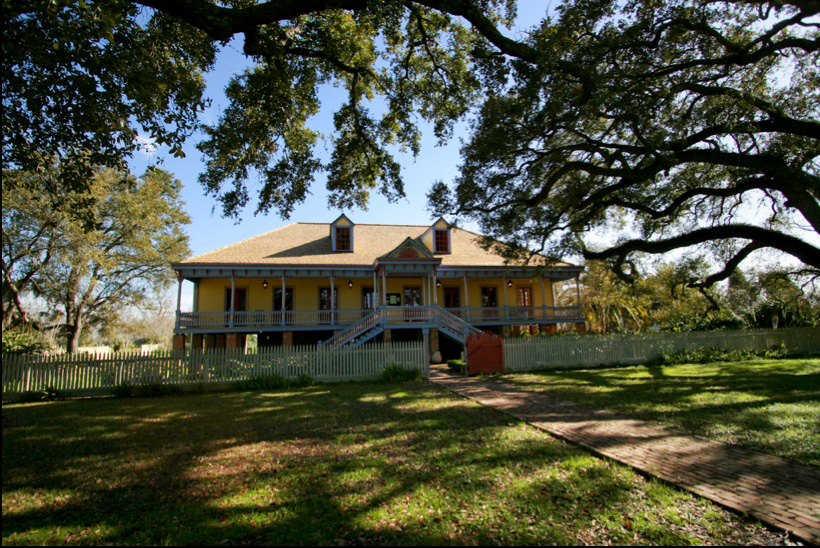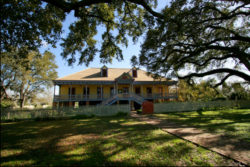Laura Plantation
Laura Lacoul Gore, the namesake of Laura Plantation, left a memoir that proved to be an important resource for the restoration of the house.

Courtesy of Alysha Jordan.
Laura Plantation is noteworthy for its Federal style interior woodwork and Norman roof truss.
Laura Plantation, built for a Creole family at the outset of the nineteenth century, sits amid sugarcane fields in Vacherie, on the west bank of the Mississippi River in St. James Parish. The manor house was severely damaged by an electrical fire in 2004, and full restoration of the home took twenty-eight months to complete. Laura’s proprietors of the past two decades have gone to great lengths to document and share the histories not only of the families who owned and operated the plantation but also of the slaves who lived and labored there.
Having acquired the property in 1805 French-born Guillaume DuParc, the former commandant of the Spanish post at Pointe Coupée, and his wife, Nanette Prudhomme, built this house in 1805 on what grew to be a 12,000 acre tract. Raised on brick piers and constructed of brick between posts, the house was five rooms wide and two rooms deep, with front and rear galleries and covered by an umbrella roof on a Norman truss. Side galleries added in the 1820s were enclosed for use as bedrooms in 1822. By the early twentieth century, the house had a projecting gabled entrance porch with a sunburst motif and double stairs in front, and the gallery was adorned with Eastlake brackets and with sawtooth trim along the roof. The house is painted in the varied bright colors preferred by Creole families: yellow exterior walls, green shutters, white and red trim, and a red roof.
Laura’s history is unique in that for nearly a century the plantation was managed by women, first by Guillaume’s widow, Nanette, then by her daughter, Elizabeth, who outlived her two elder brothers and saw the business through the Civil War and Reconstruction period. With her husband, French immigrant Raymond Locoul, who owned vineyards in France, Elizabeth operated a distribution center for Bordeaux wine; more than 10,000 bottles of wine were stored on the ground floor of the house. In 1876, Elizabeth divided the plantation equally between her daughter, Aimée, and her son, Emile. When Laura Locoul Gore, Elizabeth’s granddaughter, inherited the house, she had already decided to move north, so she sold it in 1891 to Florian Waguespack on the condition that the plantation carry her name. Her memoir, written in 1936, proved an important source for the interpretation and restoration of the site, begun in 1992 by Norman and Sand Marmillion. The house opened for tours in 1994.
Outbuildings at Laura include a two-story dowager house, built in 1829 for Nanette DuParc. Constructed of brick with wood sheathing on the exterior, the house is five rooms wide and one room deep. In addition to two cottages and farm buildings, including a barn, six small slave cabins survive, but since the latter were extensively reworked in the late nineteenth century, they should be dated to that era. Laura and neighboring plantations are home to the Creole folktales of Compair Lapin et Compair Bouki, recorded by Alcée Forier; similar stories were made famous in Engligh by Joel Chandler Harris as the Tales of Br’er Rabbit and Br’er Fox. The stories are based on tales brought from Africa by slaves and handed down to their descendants.
